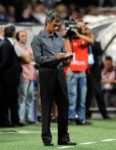Another football season lies ahead, and local teams up and down the country are preparing themselves for a tough, energy-sapping year. But teams that hope to lift some silverware will need to leave no stone unturned when it comes to match preparations, fitness and technical development. And all of these facets of the beautiful game require equipment.
Giving players a safe and constructive environment in which to develop as individuals – and as a team – involves giving them access to the right tools for the job. Every team, from the local pub team to Real Madrid, has to ensure that their coaching inventory is up to the job before the season begins. And there are some items of equipment no team can be without.
Footballs
Depending on the age group, teams and clubs should ensure that they have a supply of regulation-size balls. In order to ensure effective coaching sessions during which all players in a team get the development they need, it’s a good idea to ensure you have one ball for every player – and around 25 percent more in reserve.
Adult teams will need size-5 balls, but there are also specialist mini footballs available that can be used to develop some very specific skills. For instance, a futsal ball is much smaller and heavier than a standard football. A lot of coaches use futsal as a developmental tool, as it encourages players to pass on the ground more, retain possession and work on their first touch.
Portable goals
Effective training sessions require that different scenarios are set up on training pitches quickly and safely. Teams and clubs that have portable goals in their inventory will be able to set up impromptu matches and training drills very quickly. Some of these goals can be erected in a matter of seconds, and come with their own dedicated carry bag. They are available in free-standing or rooted designs, and they are lightweight and highly mobile for convenience and safety.
Rebounders
The development of control and first touch requires hours and hours of repetition. However, most local teams don’t have the time or the resources to provide the one on one tuition required. A rebounder is a small A-frame with elasticated netting that performs the function of a teammate or coach during touch and control training. The player simply kicks the ball onto the rebounder net, and then brings it under control or kicks it back onto the net when it bounces back. The ball rebounds in unpredictable directions, so players have to use both feet and work on their touch to stay in control.
Coloured bibs
Setting up team-based training drills and training matches is part and parcel of match preparations. However, time is usually of the essence for local teams, and the ability to set up these sessions quickly and without fuss is essential. A set of high-vis, durable and breathable training bibs ensures that teams can be organised in seconds. A range of colours and sizes are available, so players of all age groups can be split into smaller training teams with ease.
Training cones and markers
Whether players are taking part in training matches, fitness sessions or development drills, coaches will usually need to set out the boundaries of their training areas with markers and cones. There are some highly durable, plastic markers and cones on the market that stand up well to being kicked and stood on throughout the course of a season. They come in sets of up to 50, and colour coding means different training areas can be clearly identified by players.
Resistance and strength training equipment
More and more local and amateur football teams are coming round to the fact that strength and conditioning are vital factors in a player’s ability to perform. Strength and conditioning are essential to a player’s ability to use explosive acceleration from a standing start. Lower-body strength is also crucial to a player’s ability to remain balanced and in control of the ball when under pressure from the opposition.
Players don’t need to spend hours at the local gym lifting weights to reap the rewards of strength and conditioning. They can get all the same benefits from having access to some specialised items of equipment.
Dumbbells and kettle bells can be used in a number of ways to develop upper body strength. Power speed resisters use the weight of a teammate to develop a player’s lower-body strength. Resistance bands can be used to strengthen and condition key muscle groups in the both the upper and lower body. And speed parachutes give players the opportunity to work on their lower-body strength without the help of a teammate or coach.
There are several low-cost items of strength and resistance equipment that can help players to maintain their core-body strength throughout the course of a season, including balance boards, fitness rope, ab-wheels, doorway gym bars and medicine balls.
Agility and speed equipment
The ability to use speed and agility to create and prevent opportunities during a match is part and parcel of modern football. The game is faster and more physical than ever before, so working on speed and agility is of paramount importance. Fortunately, football coaches have access to a huge range of equipment that makes setting up the necessary training drills very easy indeed.
Agility hurdles get players working on co-ordination and leg speed, while bounce-back hurdles provide obstacles that simply return back to their original standing position when they have been knocked over by trailing feet. Multi-directional speed ladders allow several players to make use of the same item of equipment at the same time – developing leg speed, lower-body strength and awareness of where other players are. Slalom pole sets can be used to develop ball skills and strengthen the muscles required for effective lateral movement.
Building fitness levels, improving technical skills and cultivating tactical awareness are inescapable facets of football training in the 21st century. Teams that have access to the high-quality equipment needed to deliver this training will maximise their chances of success this season.
Author bio
Malcolm Cox is a journalist, copywriter and blogger who has been writing for online and offline publications for more than 20 years. Specialising in sport – and predominantly football – Malcolm writes extensively for sports equipment retailer The Soccer Store.









Recent Comments